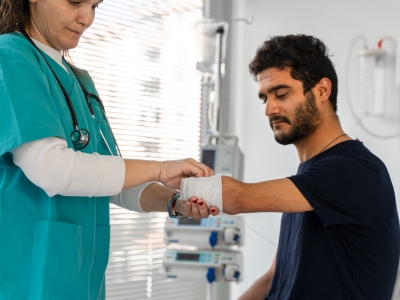
An amputation entails the partial removal of a limb. While surgeons do their best to reconstruct the affected limb, these surgeries carry the risk of complications. These problems can lead to post-operative management and recovery difficulties and issues dealing with the surgery. There are many reasons why an amputation is required, including for medical reasons following an accident. For educative purposes, here are seven common problems from limb amputations that can occur.
Pain
Pain is considered an inevitable part of amputations and their recovery. There are several types of pain doctors discuss regarding post-operative complications of amputations. There is pain associated with the trauma of the surgery that is often accompanied by phantom pain.
Phantom limb pain is a neuropathic pain presentation where the patient feels like they have pain in the amputated limb that is no longer there.
Post-amputation pain can be further complicated by pain resulting from other injuries to the rest of the body or the same limb, which is typical in the case of catastrophic accidents.
Victims might also have neuromas (localized pain) and vascular pain.
Tissue Necrosis
This complication occurs if the amputated area has poor tissue perfusion. Poor perfusion leads to necrosis (tissue death) and ischemia (restricted blood flow to the affected part). The skin around the amputation site might get discolored or fall off depending on the issue’s severity.
Necrosis and ischemia can lead to the wound breaking down and the stitch sites opening up. If that happens, a doctor will recommend revision surgery or debridement to correct the issue.
Infections and Wounds
Infections at the surgical site are common after amputations. They can make healing more difficult, increase the time before a patient has a prosthetic fitting, and worsen phantom pain. Infections also increase patient morbidity risks, requiring careful management. The risk of infection increases due to factors like smoking, old age, and diabetes.
Muscle Weakness and Joint Instability
Muscle weakness and joint instability are not uncommon post-amputation. They happen because other structures, such as joints and muscles, must compensate for the amputated limb. Because they are required to perform additional functions or bear additional loads, these stresses can lead to pain, stiffness, and muscle spasms.
Patients must start functional rehabilitation as early as the first day after surgery to diminish these effects and those associated with long bed stays and little mobility. Personalized exercise programs have also been shown to help reduce strain on the compensatory and complementary structures that will do most of the work post-recovery.
Autonomic Dysfunction
Trauma that affects the limbs, such as that caused by an amputation, can lead to complex regional pain syndrome (CRPS). Patients experience distal pain, pain caused by a stimulus that would otherwise not cause it, and motor function difficulties. This condition can also affect the sympathetic nervous system, causing the swollen limb to appear swollen and hot.
CRPS is a complex condition, and we have little understanding of its mechanisms of action. Treatments are multifaceted and require multidisciplinary teams of psychologists, physiotherapists, and neurologists.
CPRS can also increase hospital stay lengths, the number of hospital visits, and the medication the amputee takes to manage it, leading to high medical and treatment costs. Victims who have undergone an amputation after being involved in an accident can sue for these medical costs and other damages, including pain and suffering.
Edema
Stump edema is caused by the amputation’s trauma and the improper handling of tissues during the surgery. There is an imbalance of lymph fluid transfer across the lymphatic system and the capillary membranes post-surgery, with the issue exacerbated by reduced muscle contractions, tone, and activity.
The pooling of fluid in the affected area can lead to prosthetic fitting difficulties, reduced mobility, pain, and wound breakdown. Fortunately, modern medicine gives doctors options and interventions to use when this issue arises to ensure better patient outcomes.
Skin Blisters
Surgical wounds need sterile dressing. However, issues can arise during their application. Such issues include tight dressings, the use of dressings with little elasticity, or the use of abrasive dressing that causes friction in the applied area. All these factors can lead to blisters that can worsen if the patient has edema.
Additional issues that can cause them include allergic reactions to medications, traction, and infections.
Although necessary in specific situations, amputations cause trauma and additional issues that the patient or victim has to deal with. They also lead to a decreased quality of life and, in many cases, an inability to support oneself. Adjusting to life following the surgery will also seem daunting, but many people live a good life with rehabilitation and management.
Additionally, you have the right to sue for damages to receive a settlement that helps you with any financial obligations now and in the future. Our injury attorneys at Custodio & Dubey LLP can help you file a lawsuit for a catastrophic injury that leads to an amputation.
Visit our offices to talk to our attorneys at 445 S Figueroa Street Suite 2520 Los Angeles, CA 90071.
Call now for a free consultation at (888) 200-9431.
Practice Areas
Amputations | Bicycle Accidents | Brain Injuries | Burn Injuries | Car Accidents | Dog Bites | False Advertisement | Environmental Litigation | Slip and Fall | Wrongful Death | & more.

